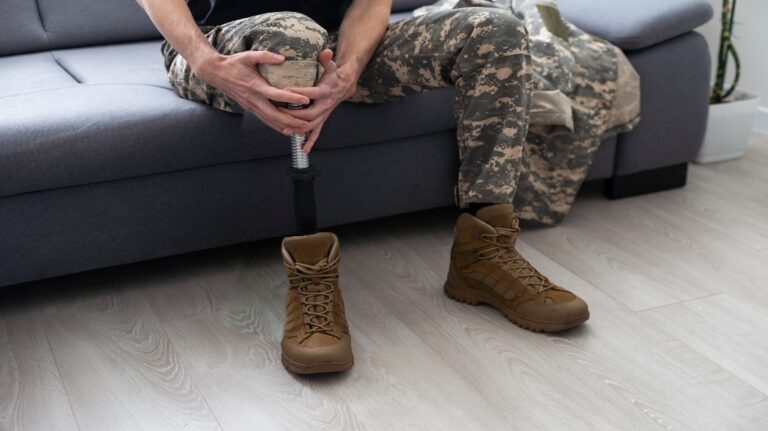
The transition from military service to civilian life is challenging – and sometimes, the invisible wounds of war manifest later in life and may lead to disability. If you’re a veteran with a service-connected injury, illness, or medical condition, navigating the U.S. Department of Veterans Affairs disability claims process can feel daunting – but you don’t have to do it alone. Veterans Law Attorneys specializes in helping veterans secure the disability benefits they deserve. Here, we unveil the Top 10 Easiest Injuries to Claim for VA Disability in 2024, helping you understand common conditions and the importance of seeking legal guidance throughout the claims process.
What Are the Easiest VA Disability Claims to Win?
While the Department of Veterans Affairs considers each disability claim based on individual medical and service records, some service-connected injuries, illnesses, and medical conditions are more likely to be approved by the VA due to how prevalent they are in military personnel. Here at Veterans Law Attorneys we want to help create a better understanding of the U.S. Department of Veterans Affairs, disability claims, and disability ratings with a list of service-related injuries that have a high approval rate.
Here is a better look at service-connected injuries with high claims success rates and a quick description of each medical condition.
- Tinnitus
- Limited Knee Mobility and Pain
- Sciatica
- Hearing Loss
- Cervical Strain
- PTSD
- Limited Arm Mobility and Pain
- Limited Ankle Mobility and Pain
- Migraines
- Scar Tissue

Tinnitus
Tinnitus is a constant ringing, droning, or buzzing in the ears and is one of the most common service-connected disabilities among veterans. More than 2.9 million veterans receive VA compensation for tinnitus and its prevalence highlights the lasting impact military service can have on your hearing. Tinnitus carries a disability rating of 10%.
Limited Knee Mobility and Pain
Battered knees are a common injury for veterans due to hard training and military service in theater. More than 1.8 million veterans receive VA disability compensation for limited knee mobility and pain. The VA rating system considers the severity of limitations. Limited movement can qualify for a rating up to 30%, while constant pain with significant restrictions can reach 60%.
Sciatica
Sciatica – paralysis of the sciatic nerve – is the shooting pain caused by a compressed sciatic nerve and it impacts many veterans with more than 1.5 million veterans receiving VA disability compensation for the medical condition. The VA assigns disability ratings based on severity and symptoms of sciatic, ranging from 10% for mild discomfort to 80% for constant, debilitating pain and paralysis.
Hearing Loss
Service-connected hearing loss is a prevalent disability among veterans, affecting over 1.49 million who receive disability compensation. This hearing loss can be conductive (outer/middle ear issues), sensorineural (inner ear damage), or mixed (a combination). The VA disability rating considers the severity and type, ranging from 0% for slight impairment to 100% for profound deafness requiring constant hearing aid use.
Cervical Strain
Neck pain – cervical strain – from military service is a major concern, with over 1.4 million veterans receiving VA disability compensation for service-connected cervical strain. This medical condition can be due to poor posture, carrying a heavy pack, injury, or leaning over a computer. The VA assigns disability ratings based on limitations in neck movement and pain severity. These ratings range from 10% for slight limitations to 100% for constant, debilitating pain, nerve damage, and your spine stuck in an uncomfortable position, with increases at 20%, 30%, 40%, and 50% depending on the degree of impairment.
PTSD
Not all wounds suffered in combat are visible. More than 1.45 million veterans receive VA disability compensation for Post-Traumatic Stress Disorder (PTSD) – which manifests in flashbacks, nightmares, anxiety, depression, and more. The VA assigns disability ratings based on the severity of symptoms and their impact on daily life. These ratings range from 10% to 100% with breaks at 30%, 50%, and 70%. A 100% disability rating for PTSD indicates complete occupational and social impairment due to symptoms – while a 10% disability rating indicates symptoms that come and go and decrease your ability to work or socialize.
Limited Arm Mobility and Pain
Many veterans face limitations due to service-connected limited arm mobility and pain. More than 1.03 million veterans currently receive VA compensation for this condition. The VA assigns disability ratings based on the severity of limitations in movement and pain intensity with disability ratings that range from 0% to 40%.
Limited Ankle Mobility and Pain
An estimated 1.02 million veterans struggle in their day-to-day lives with service-related limited ankle mobility and pain. Damage to bones, ligaments, tendons, and muscles is common in the military and can significantly restrict movement and cause chronic pain. The VA acknowledges this with disability compensation, although the highest rating for ankle pain is capped at 20%.
Migraines
Migraines are a debilitating reality for many veterans, affecting over 950,000 who receive VA disability compensation. Severe migraines can be accompanied by nausea, vomiting, and sensitivity to light or sound. The VA recognizes the impact these migraines have on daily life, assigning disability ratings from 0% to 50% with interim breaks at 10% and 30%. Veterans experiencing chronic and prostrating migraines should seek a VA evaluation to determine their eligibility and appropriate rating.
Scar Tissue
Scars serve as a lasting reminder for veterans of service-related burns, injuries, surgeries and more and an estimated 937,000 veterans receive disability for excessive scar tissue. These scars can limit mobility and function, and the VA acknowledges this with disability ratings ranging from 10% to 80%. While the average rating is 10%, veterans with significant limitations due to scar tissue should seek a VA evaluation.
READ MORE: What Is the VA Benefits Cost-of-Living Adjustment in 2024?
While this list highlights some of the Top 10 Easiest Injuries to Claim for VA Disability in 2024, it’s important to remember that every veteran’s case is unique. If you’re a veteran experiencing any health issues that are service connected and impact your day-to-day life, don’t hesitate to seek help. Veterans Law Attorneys in Cincinnati, OH is dedicated to advocating for veterans and can guide you through the VA disability claim process every step of the way. Contact Veterans Law Attorneys today for a FREE consultation and ensure you get the benefits you deserve!






